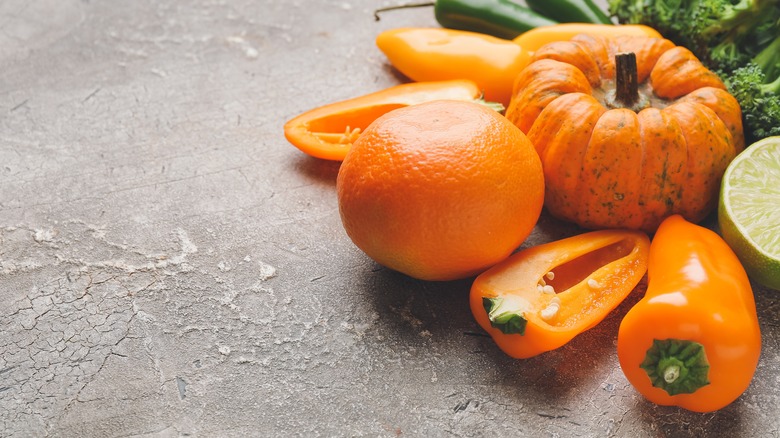Don't Be Fooled By The Pumpkin Spice Jalapeño
To all the PSL lovers out there, prepare to be amazed. Pumpkin spice season is just around the corner, and year after year, it's always amazing to see what new pumpkin spice-flavored products will be released. From the basics like pancake mix and pop-tarts, to pumpkin-flavored peanut powder and cotton candy (via Taste of Home), the options have been rather endless to food manufacturers. But right when you thought companies had maxed out on creativity, the pumpkin spice jalapeño pepper was born.
What can't they do? Well, you're in for a surprise if you expect these fresh orange peppers to taste like a pumpkin spice latte from Starbucks. According to Atlas Obscura, these peppers are called pumpkin spice jalapeños due to their orange hue and "spice" level. No, we're not talking about hints of nutmeg, cinnamon, and clove — we're talking about the heat that comes from a jalapeño pepper. However, they do taste a bit more fruity than your average pepper.
Where did they come from?
The brand associated with these peppers is called NuMex, which is developed by New Mexico State University's Chile Pepper Institute. According to Bustle, the Institute is constantly in development with new types of peppers, all having very intriguing names. They've come up with peppers called the Twilight Pepper because it changes colors, the Valentine's Day Pepper because of its ivory and red color, and even an Easter Pepper which starts out lavender and changes into a yellow and orange hue. This institute names their peppers based on their appearance, which means that while the Pumpkin Spice Jalapeño may be the same color as a pumpkin, it doesn't taste anything like it.
Specialty Produce states that the pepper belongs to the nightshade family. When developing the pepper, they bred permagreen bell peppers and an early jalapeño with the goal of producing a more colorful jalapeño.
These peppers have real spice, not seasonal spice
According to a journal posted by HortScience in 2015, these pumpkin spice peppers have been in the works since 1995, along with NuMex Lemon Spice and NuMex Orange Spice peppers. We as humans typically think of the word spice as a seasoning, whereas the Chile Pepper Institute bases it on the level of capsaicin, a.k.a. heat. Here's where it gets interesting.
The HortScience journal states that the Lemon Spice and Pumpkin Spice peppers clock in at 25,000 Scoville Heat Units – a bit spicier than a normal jalapeño, which falls between 2,500 and 8,000. However, the Orange Spice pepper clocks in at 80,000 Scoville Heat Units, similar to Thai chiles. With NuMex's Pumpkin Spice pepper being tolerable to those who love spice, it makes for a great addition to dishes or for snacking.
But if you're ever on a hunch for some pumpkin spice in your life, the pumpkin spice pepper won't fulfill your craving — and it might be best to opt for a latte instead.


